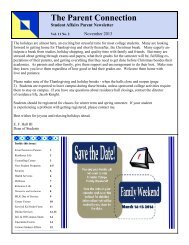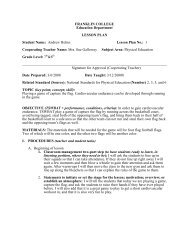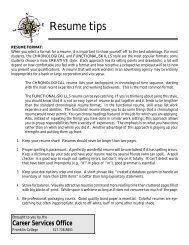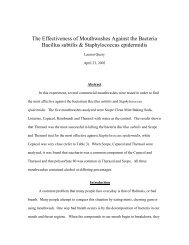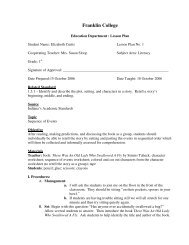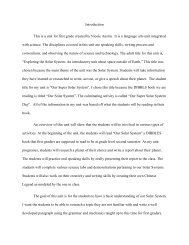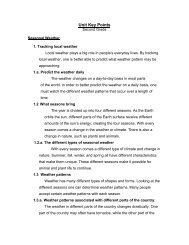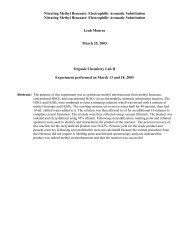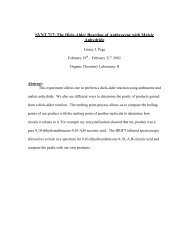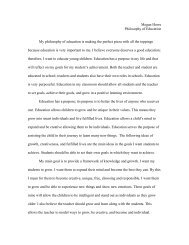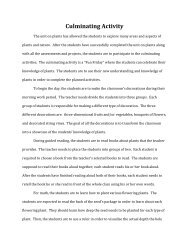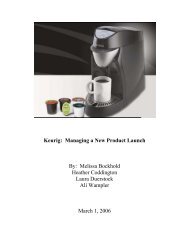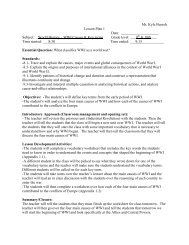The Patchwork Quilt - Franklin College
The Patchwork Quilt - Franklin College
The Patchwork Quilt - Franklin College
Create successful ePaper yourself
Turn your PDF publications into a flip-book with our unique Google optimized e-Paper software.
FRANKLIN COLLEGE<br />
Education Department<br />
LESSON PLAN<br />
Student Name: Charla Speer Lesson Plan No. 8<br />
Cooperating Teacher Name: Mrs. Rauls Subject Area: Reading Grade Level: 3<br />
Signature for Approval (Cooperating Teacher)<br />
Date Prepared 1-26-03 Date Taught 1-28-03<br />
TOPIC (key point; concept; skill):<br />
<strong>The</strong> <strong>Patchwork</strong> <strong>Quilt</strong><br />
OBJECTIVE (TSWBAT + performance, conditions, criteria): In order to gain<br />
understanding of the story <strong>The</strong> <strong>Patchwork</strong> <strong>Quilt</strong>, TSWBAT write answers to questions<br />
about the stories comprehension and vocabulary after the class has read the story aloud<br />
and under the direction of the teacher.<br />
MATERIALS: McGraw Hill Reading Unit 3 student and teacher’s editions; Language<br />
Support page 101; worksheet pages 89, 90; teaching chart 74; overhead projector,<br />
marker; chalk, chalkboard; pencil; homemade quilt.<br />
I. PROCEDURES (teacher and student tasks)<br />
A. Beginning a lesson<br />
1. Classroom management step (to have students ready to learn, in listening<br />
position, where they need to be): “Please clear off your desks. One person from<br />
each table needs to get the reading book, keep them closed until I tell you<br />
differently and then put all eyes on me when you are ready to begin.” <strong>The</strong> teacher<br />
will praise individual students for following directions. If there are still
stragglers, the teacher will call on these students individually and ask if they are<br />
ready to begin.<br />
Statement to initiate or set the stage for the lesson; motivation; review:<br />
<strong>The</strong> teacher will say, “This is a quilt that my mom made for me before I left for<br />
college. <strong>The</strong> squares are made from old curtains from my room. We both sat and<br />
worked on it during the summer together. It was so much fun and one of the best<br />
memories that I have from the days before I left for school. <strong>The</strong> quilt is a part of<br />
me and reminds me of my family whom I don’t get to see as often as I would like.<br />
While we are reading today’s story, I want all of you to think of a special memory<br />
from your family.”<br />
Instruction Steps:<br />
*= Modifications (strategies to meet individual, special needs: either at a<br />
particular step or in general for the lesson)<br />
1. <strong>The</strong> teacher will write the following words on the chalkboard: anxious,<br />
attic, costume, examined, gazed, pattern. She will then ask students to<br />
read the words aloud together as a class.<br />
2. She will then put Teaching Chart 74 on the overhead projector and ask a<br />
student to read the transparency.<br />
3. <strong>The</strong> teacher will ask students to identify the vocabulary words and the<br />
teacher will circle them. <strong>The</strong>n the teacher will underline words that the<br />
students’ say gives clues to the words meaning.<br />
4. <strong>The</strong> teacher and students will then discuss the meaning of each of the<br />
words.
5. <strong>The</strong> students will then be directed by the teacher to turn in their books to<br />
page 320 where the teacher will ask the students to read the title and take a<br />
picture walk, looking for pictures that give strong clues about the plot and<br />
characters. <strong>The</strong> teacher will ask for predictions and clues.<br />
6. <strong>The</strong> teacher will read the paragraph about the author and then ask the<br />
students if this gives them any clues to what the story will be about.<br />
7. <strong>The</strong> teacher will then read the strategic reading section on making<br />
inferences and pass out the students a chart and ask them to get out a<br />
pencil.<br />
8. <strong>The</strong> students and teacher will read the selection, stopping from time to<br />
time to ask comprehension questions and to make inferences.<br />
B. Closure statement (brief lesson review, summary; what will follow;<br />
doesn’t have to be the last step if something is going to be made or an<br />
activity will follow): After the story is read the teacher will ask volunteers to<br />
tell the major events of the story. Students may refer to their charts. <strong>The</strong>n the<br />
teacher will ask a student in one or two sentences to summarize the story.<br />
<strong>The</strong> teacher will then review with the students their predictions and see if they<br />
were correct and if they found out what they wanted to know. <strong>The</strong> teacher<br />
will have the students make inferences about Tanya’s character from her<br />
actions. She will ask them to explain the inferences they make. <strong>The</strong> teacher<br />
will then say, “We should recognize that making inferences can help us<br />
understand a character’s feelings, thoughts, and motivations. Now that we’ve<br />
finished our reading, let’s get started on an assignment.”
9. <strong>The</strong> teacher will then ask the student to get out their weekly packet for<br />
reading. She will then ask the student to do pages 89 and 90 (the teacher<br />
will write this on the chalkboard) and then she will go over the directions<br />
with the students.<br />
II. ASSESSMENT (objective met by students: observation, written work,<br />
presentations, quiz, etc.): <strong>The</strong> teacher will ask comprehension and inference<br />
questions throughout the story in order to gain an understanding of how well the<br />
students understand the story. She will attempt to call on students of all learning<br />
abilities to see who is in need of further remediation. A grade will be taken on the<br />
worksheet pages. Student who miss no questions will receive an A+, missing one<br />
question will result in a B, missing two questions will result in a C, missing three<br />
questions will result in a D, missing four or more will result in an F on both pages<br />
89 and 90.<br />
III. EXTENSION AND REMDEIATION (what will be done beyond lesson;<br />
strategies for those who need further Instruction, assistance):<br />
Extension:<br />
Group: If a group extension is needed the teacher will ask the students to<br />
make another list of inferences that they can make about Tanya’s character.<br />
Individual: If an individual student is in need of an extended lesson, the<br />
teacher will ask the student to make another list of inferences that they can make<br />
about Tanya’s character.
Remediation:<br />
Group: If the entire class is having is in need of remediation the teacher<br />
will review parts of the story and give them additional examples of inferences in<br />
the story.<br />
Individual: If an individual is in need of remediation the teacher will<br />
review parts of the story and give the student additional examples of inferences in<br />
the story as well as question the students through follow up questions.<br />
IV. HOMEWORK ASSIGNMENT(S): No assignment.



